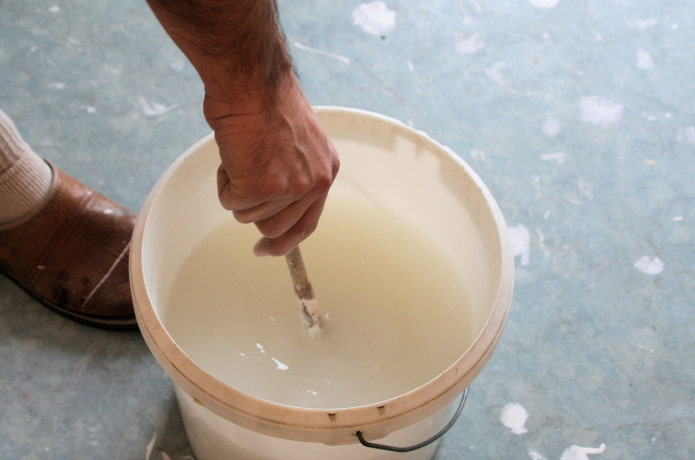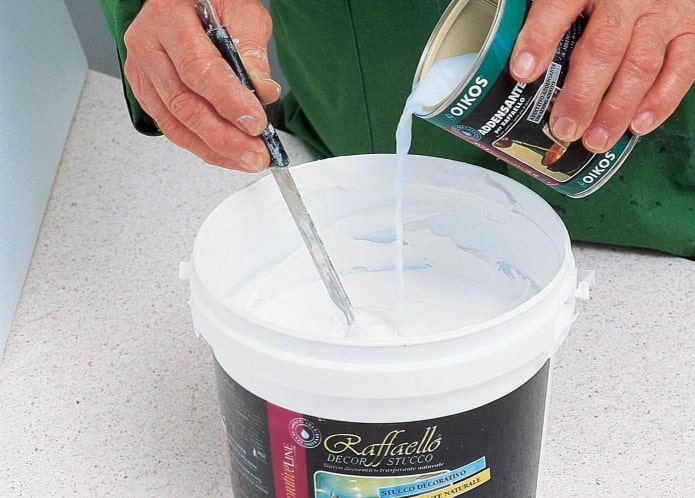Strengthening mixture
Soap, glue, copper sulfate
Strengthening is essential for plastered or concrete surfaces — the main task of such a primer is to “bond” the particles of the coating together even better and protect the wall from crumbling. To prepare a solution to improve strength at home, you will need:
- 1 bar of laundry soap (~25 rubles for 200 g);
- 100 g of copper sulfate (~100 rubles/package);
- 500 g of dry bone glue (~250 rubles);
- 7 liters of clean water.
So, 7.8 kg of primer will cost you about 375 rubles. For comparison, 5 liters of CT 17 primer from Ceresit costs an average of 630-650 rubles. But to save almost 2 times you will have to spend a little time:
- Pour 7 liters of water into a metal container (an unnecessary saucepan or bucket will do).
- Put it on the stove.
- As soon as the water starts to boil, grate or finely chop the laundry soap.
- Pour the soap into boiling water, stirring with a stick or wooden spatula until it dissolves completely.
- Set the minimum temperature on the stove.
- Add glue and copper sulfate.
- Stir.
- Cover and leave for half an hour.
- Strain the warm, slightly cooled mixture through cheesecloth, leave until it cools completely.
Apply the cooled mixture to the walls with a brush or roller. Thanks to the glue and soap, the coating will be strengthened, and copper sulfate will protect against mold and mildew.

Deep penetration composition
PVA glue and cement
A separate class of primer compositions is designated by the “deep penetration” label. The primer is used for highly absorbent surfaces: it prevents dust formation, strengthens and, most importantly, reduces and evens out the absorption capacity.
To prepare a deep penetration primer, you will need:
- 1 liter of PVA glue (from 80 to 300 rubles per 1 kg);
- 1 trowel (~200 g) of cement (20 rubles per 1 kg);
- 8 liters of clean water.
The total cost of 9200 kg of primer is from 100 to 320 rubles, depending on the type of PVA glue. Liquid plasticizing composition is the cheapest, it is great for making a primer. But to reduce the absorption capacity as much as possible, you can take expensive PVA glue – for example, Moment Stolyar. It is more concentrated and has better adhesive properties.
For comparison, 10 liters of Bergauf TiefGrunt solution will cost about 595 rubles.
Preparing a deep penetrating solution is much easier than a strengthening one, especially if you arm yourself with a construction mixer.
- Pour 8 liters of warm water into a basin or bucket.
- Add 1 liter of PVA glue, mix thoroughly until completely dissolved.
- Pour in cement, mix again. The composition is ready!
Important! Before covering all the walls with homemade primer, check whether it has been prepared correctly. To do this, cover a small area with the composition and wait until it dries – there should be no film left on the surface that can be removed. If this does form (it happens when the PVA is too thick), add some water and test again.

To improve adhesion
The so-called adhesion primer improves the adhesion between the decorative finishing material and the base. But the finish can be different and the primer required for it is also different. Let’s look at the main options.
Under the wallpaper
The surface under the wallpaper should not:
- crumble;
- become moldy;
- absorb glue.
The primer is responsible for all this. To treat the walls, you don’t need to buy a special composition or prepare it from complex ingredients – regular wallpaper glue is enough. Mix it at a rate of 100 g per 4 liters of water, apply it to the walls with a roller or brush, wait until it dries completely and start gluing.
Important! See the instructions on the packaging: often the manufacturers themselves write the mixing proportions for pre-treatment.

For painting
For the paint to lay down well and last a long time, it is necessary:
- a strong (not crumbly) base;
- a uniform level of moisture absorption;
- a monochromatic surface without stains.
Many experts simply dilute the paint with water, which they will use to paint the walls or ceiling in the future, and apply the first primer coat to it. But if the paint does not contain antifungal additives or special adhesive additives, and it is to be applied to a very smooth surface (for example, over old oil paint), it is better to make a special solution.
To do this, take:
- a bar of laundry soap (~25 rubles for 200 g);
- 200 g of wallpaper glue (~70 rubles);
- 250 g of aluminum potassium sulfate – alum (~300 rubles);
- 2000 g of chalk (~100 rubles per 1 kg);
- 30 ml of drying oil (~90 rubles for 500 ml);
- 3 liters of water.
Alum can be purchased at a pharmacy or a store for making cosmetics and perfumes. Chalk powder can be found in hardware stores, where you will also find glue and drying oil.
5700 g of ready-made primer will cost about 600 rubles.
- Add 1 liter of boiling water to the alum.
- Grind the laundry soap.
- Dilute the glue in 2 liters of water, avoiding lumps.
- Heat the water with the glue over low heat, add the soap shavings, wait until it dissolves completely.
- Pour in the drying oil and diluted alum, add the chalk powder, mix thoroughly so that there are no lumps.
Important! The primer should be liquid – if the composition has thickened too much, dilute it with boiling water to the consistency of kefir or even milk.

For wood treatment
Wood primer deserves special attention. When buying a primer in a store, you can immediately see what problems it solves, usually it is protection from moisture, fungus, insects and fire. Thanks to the primer, the service life of the finishing coating (paint, varnish, stain) is also increased.
The recipe described above is suitable for wood – using alum and drying oil. But if this option seems too complicated for you, try the simplest PVA-based solution. To do this, mix 1 part glue and 2 parts water. For example, 500 g of glue and 1 liter of water.
The cost of the finished composition will be estimated by the cost of PVA – from 80 to 300 rubles for 3 kg.

Even if it is impossible to find a primer in your stores, do not skip this stage during the repair. Feel free to make it yourself, especially since some recipes contain very simple components that can be found at the nearest retail outlet.
Now reading:
- 3D Wallpaper for Walls: 80 Stylish Ideas for Bedrooms, Kids Rooms and Other Rooms
- Kitchen-living room 16 m²: 40 photos, layouts and stylish design ideas
- Kitchen and living room zoning: over 60 photos and creative ideas from designers
- Wooden house design: more than 80 photos and real interior examples
- 15 Creative Ways to Use Wicker Baskets for Home Decor.